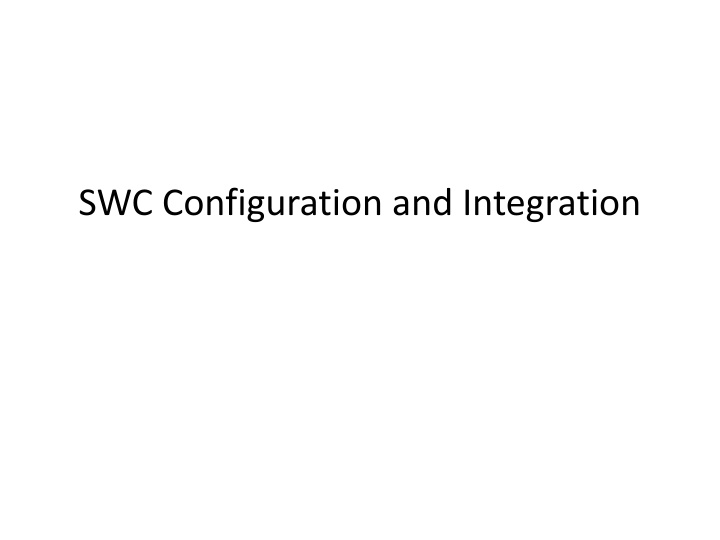
Software Components Configuration and Integration Guide
This guide covers SWC configuration and integration, including defining software component settings, configuring behavior, integrating components, and handling errors. Learn about the process, benefits, considerations, and techniques involved in efficiently configuring and integrating software components within a system.
Download Presentation

Please find below an Image/Link to download the presentation.
The content on the website is provided AS IS for your information and personal use only. It may not be sold, licensed, or shared on other websites without obtaining consent from the author. If you encounter any issues during the download, it is possible that the publisher has removed the file from their server.
You are allowed to download the files provided on this website for personal or commercial use, subject to the condition that they are used lawfully. All files are the property of their respective owners.
The content on the website is provided AS IS for your information and personal use only. It may not be sold, licensed, or shared on other websites without obtaining consent from the author.
E N D
Presentation Transcript
Introduction SWC Configuration: Defining the settings and properties of software components. SWC Integration: Combining and coordinating software components within a system.
SWC Configuartion Definition: Configuring the behavior and properties of individual software components. Configuration Parameters: Customization: Configure component behavior according to system requirements. Properties: Set parameters such as timing, resource allocation, and communication interfaces. Benefits: Flexibility: Adapt component behavior without modifying underlying code. Reusability: Configure components for different systems without redevelopment.
Configuration Process Identify Configuration Requirements: Analyze system requirements and determine necessary component configurations. Define Configuration Parameters: Specify configurable properties and parameters for each SWC. Configure SWCs: Set values for configuration parameters based on system requirements. Validate and Verify: Ensure configured SWCs meet system requirements and perform as expected. Documentation:Document the configuration details for future reference.
SWC Integration Definition: Combining and coordinating multiple software components within a system. Integration Considerations: Interfaces: Connect and establish communication between SWCs. Data Exchange: Define data formats and protocols for inter-component data exchange. Timing and Synchronization: Ensure proper coordination and synchronization between SWCs. Resource Allocation: Allocate system resources such as memory and processing power. Error Handling: Implement error handling and fault tolerance mechanisms.
SWC Integration Process Component Identification: Identify the SWCs to be integrated into the system. Interface Definition: Define the interfaces and communication channels between SWCs. Data Exchange: Specify data formats, protocols, and message structures for inter-component data exchange. Timing and Synchronization: Establish timing requirements and synchronization mechanisms between SWCs. Resource Allocation: Allocate system resources to SWCs based on their requirements.
Error Handling and Fault Tolerance: Implement mechanisms for error detection, handling, and recovery. Integration Testing: Verify the proper functioning of integrated SWCs through testing and validation.
Conclusion SWC Configuration and Integration are crucial steps in developing embedded systems. SWC Configuration enables customization and reusability of software components. SWC Integration ensures proper coordination and communication between components. Effective SWC Configuration and Integration lead to reliable and efficient embedded systems.






















